Making Beef Stock from Scratch
Beef stock might not be something that you have thought of making before because it is so easy to buy pre-made, however most commercially prepared beef stocks contain FODMAPs as well as superfluous ingredients we don’t want.
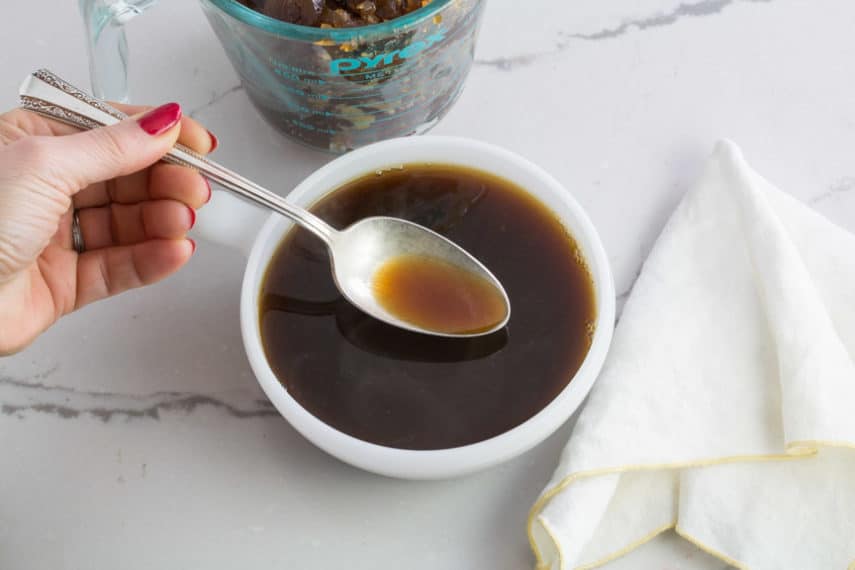
It is true that companies are cropping up with low FODMAP broths and stocks, so make sure to keep an eye out, but nothing compares to homemade. This is easy to make but you do need time.
We actually like to simmer ours on the stove for 24 hours but you will have to decide whether you feel comfortable letting it cook while you are sleeping. If you have a large enough slow cooker you can also prepare this on low for the same amount of time.
You can read about our process in our article Making Beef Stock.
Long Simmering Time Creates Depth of Flavor
The extended cooking time is necessary to yield a richly flavored stock. That said, we have to employ some tricks as well. Traditionally, onions and garlic are simmered with the bones for maximum flavor, but since this would allow the water-soluble high FODMAP fructans in the onions and garlic to leach into the stock, we cannot take that approach.
To add flavor that might be missing we take advantage of the fact that the fructans are not oil soluble and begin with browning the meaty bones in Garlic-Infused Oil. We also add some extra ingredients like umami-rich tomato paste and soy sauce, which add to the desired savory-ness that we are looking for.
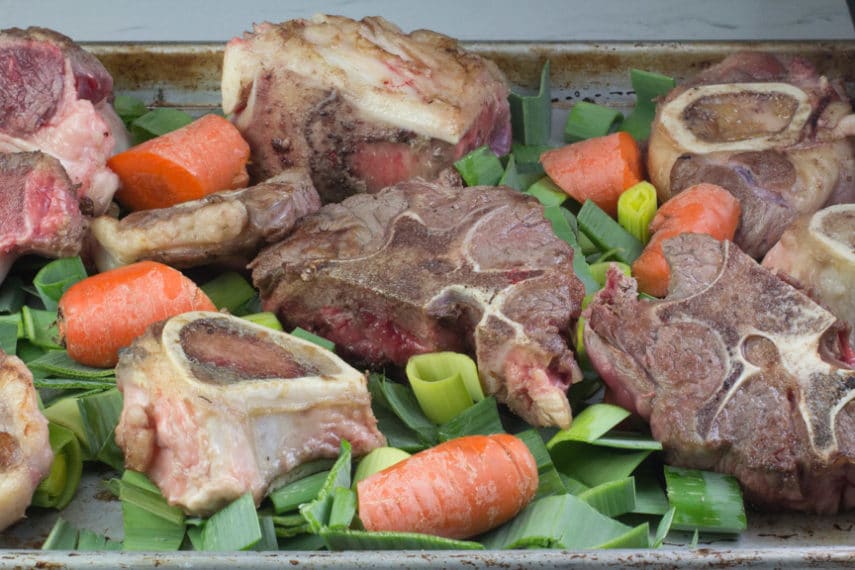
Blanching – No. Roasting – YES!
Some classic recipes recommend blanching the bones before roasting to remove impurities within the bones.
In fact, some chefs believe that stocks made from unblanched bones end up being too funky and lack finesse, however, since we have to leave out some high FODMAP ingredients, we want to retain as much flavor as we can, so we do not blanch the bones for our low FODMAP version.
We do, however, roast the bones along with leek greens and carrots, after the meaty bones have been browned in Garlic-Infused Oil. In the image above you can see the meaty bones and veggies are ready to go into a very hot oven.
We use heavy duty rimmed baking sheet pans – the same ones we use when baking cookies!
Bone Broth? It Ain’t New
By the way, the “new” terminology of calling a beef stock “bone broth” is somewhat maddening. Classic chefs have always used bones and an extended cooking time to make a rich broth. The addition of an acid like vinegar to help the bones break down isn’t new either.
Wine, which is acidic, has been part of stock making since the recipes were first developed. We can look back decades to Julia Child or even over 100 years to Escoffier to realize that a traditional Beef Stock is just having a resurgence because it is classically delicious.
If you are in a soup mood, check out our Chicken Stock and Turkey Stock recipes as well.
And if you would like to read about the bone broth “craze”, refer to this article.
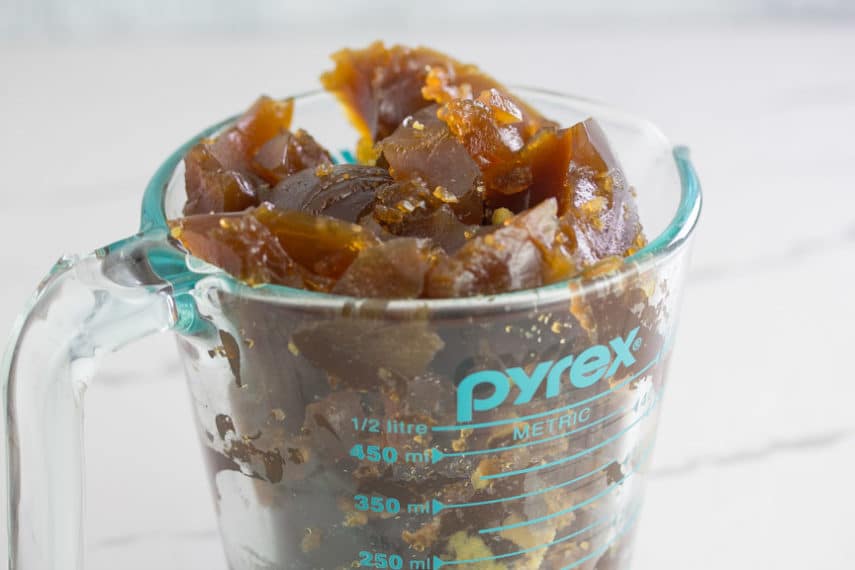
Chill Baby, Chill
In the images above and below you are looking at what we call Beef Jell-O! After cooking, cooling and straining we suggest an overnight refrigeration period, during which time the fat will congeal on the surface, allowing you to skim it away very easily.
The stock is so rich in collagen, that this is the texture that you get when chilled! After heating it liquifies into the dark, rich stock that you can see in the top photo.
You might like to check out our recipe for Pho Bo, too.
If you want to start with a prepared low FODMAP beef stock, check out this organic offering from Gourmend.
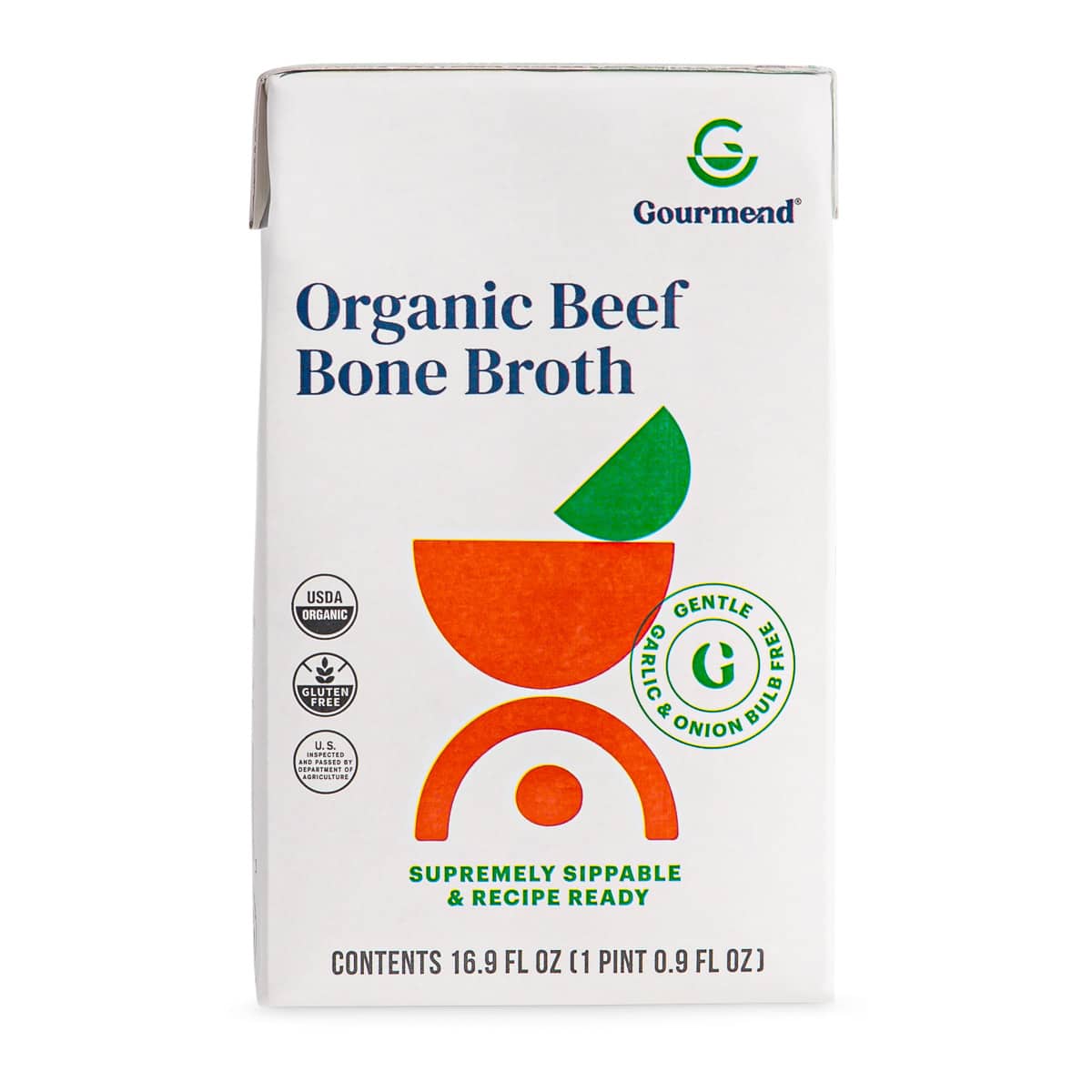
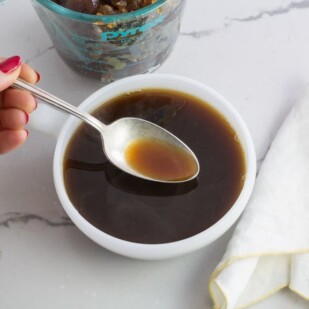
Low FODMAP Beef Stock
Low FODMAP Beef Stock is easy to make at home but make sure to allow yourself some time for the stock to simmer for hours.
Low FODMAP Serving Size Info: Makes about 2 quarts (2 L); serving size 1 cup (240 ml)
Ingredients:
- 1/4 cup (60 ml) of EITHER Low FODMAP Garlic-Infused Oil or Onion-Infused Oil, made with vegetable oil or purchased equivalent
- 4 pounds (1.8 kg) of beef bones, such as a combination of meaty neck bones, knuckle bones, oxtail and marrow bones, cut into 2-inch (5 cm) thick pieces by the butcher
- 3 cups (145 g) roughly chopped leeks, green parts only
- 2 medium carrots, scrubbed and cut into 2-inch (5 cm) pieces
- 2 medium (225 g) parsnips, scrubbed and cut into 2-inch (5 cm) pieces
- 1 medium celery stalk, cut into 2-inch (5 cm) pieces
- 2 tablespoons tomato paste
- 1 tablespoon black peppercorns
- 1 tablespoon low-sodium soy sauce, use gluten-free if following a gluten-free diet
- 2 teaspoons kosher salt
- 1/2 bunch fresh flat leaf parsley, roughly torn
- 4 medium sprigs fresh thyme
- 2 bay leaves
- 14 cups (3.3L) water
- Cheesecloth
Preparation:
-
Position rack in center of oven. Preheat oven to 450°F (230°C). Have a heavy, rimmed sheet pan at hand.
-
Heat oil over medium heat in a large 8 to 10 quart (7.5 L to 9.5 L) heavy stockpot. Add the meaty bones and begin to brown them in the oil for about 3 minutes or until you get all the meaty bone surfaces infused with the flavorful oil.
-
Scatter the leeks all over the sheet pan. Don’t wash the stockpot, as you will be returning to it shortly. Transfer the browned bones to the sheet pan on top of the leeks. Roast for 20 minutes, stir the leeks and bones around and roast for 20 to 25 more minutes or until the bones are well browned. Don’t worry if the leeks look a little charred.
-
Scrape everything from the sheet pan, juices and all, into the waiting stockpot. Add carrots, parsnips, celery, tomato paste, peppercorns, soy sauce, salt, parsley, thyme and bay leaves to pot. Add the 14 cups of water; it should cover the solids. Add more water if it doesn’t just to cover all of the ingredients by about an inch (2.5 cm).
-
Bring stock to a very low simmer. Cover but leave lid slightly ajar and adjust heat so that the stock can simmer for an extended period of time. You want the surface just rippling. Check from time to time and skim any froth that might rise to the surface and discard. Also check water levels; add water as needed to keep solids submerged. Gently simmer for at least 12 hours; we let ours simmer overnight for 24 hours, but use your judgment about whether you feel comfortable with this.
-
Line a fine meshed strainer or chinois with a quadruple layer of cheesecloth. Remove the bones and any large solid pieces of ingredients from the pot using a large slotted spoon. Pour the stock in batches through the cheesecloth to strain out any and all solid bits and pieces. You should have a nice clear dark brown stock. You can strain multiple times through clean cheesecloth if you like.
-
Cooling the stock quickly and efficiently is necessary to prevent bad bacteria from developing. We separate the hot stock into a few shallow bowls set over ice. Do not put hot stock in the refrigerator, as that will trap a lot of heat in the center, which is a perfect breeding ground for the kind of bacteria that you don’t want. Once the stock is barely warm you can refrigerate it in one airtight container overnight. A layer of fat will congeal and can be easily skimmed away and discarded. Now you have beef Jell-O! The collagen rich bones will leave you with a stock that is solid when chilled. You can refrigerate the stock for up to 5 days or freeze for up to 6 months. Use as a base for soups and stews or simply sip as a rich, restorative stock.
Notes:
Tips
- You might see recipes for “bone broth” all over the internet that exclaim that it is necessary to add vinegar to extract minerals and nutrition from the bones. First of all, it is questionable that the average 5% acidic strength of apple cider vinegar in the amount used in stock recipes has a significant effect on the nutritional aspects of the final stock. The bones will break down with extended cooking and furthermore, one of the hallmarks of a poorly made stock is sourness, which vinegar can add in the recommended amounts. Our goal is making a delicious, rich, beef low-FODMAP broth and find it unnecessary to add vinegar.
Nutrition
All nutritional information is based on third-party calculations and should be considered estimates. Actual nutritional content will vary with brands used, measuring methods, portion sizes and more. For a more detailed explanation, please read our article Understanding The Nutrition Panel Within Our Recipes.
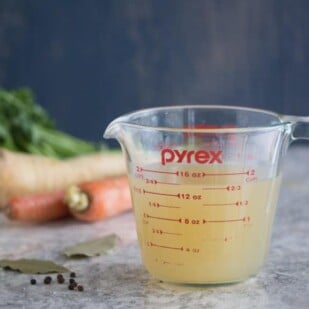
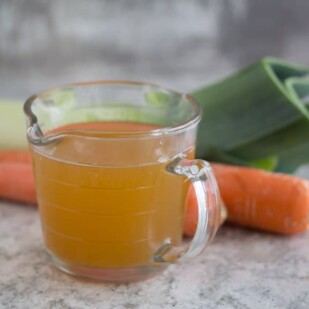






Hi my daughter has been put on a low fodmap diet but her dietitian has told her she can’t have tomato paste what can I substitute to give this stock/broth the depth you talk about?
Hi Sheena, I would ask the dietitian as to why no tomato paste? If it is because they believe it to be high in FODMAPs, I would point out that some contain high FODMAP ingredients and some do not. It is used in very small quantities and should be tolerated by most. As you can see, this recipe was certified low FODMAP by Monash University. Of course there could be a NON FODMAP reason which I am unclear about. The paste gives a depth and umami to the dish. You could try soy sauce.
I believe soy sauce is very high FODMap.
Elle, soy is a confusing food for many as it relates to FODMAPs. Some soy products are low FODMAP, such as firm and extra-firm tofu, miso, soy milk made with soy protein (not whole soybeans) and even edamame! Soy sauce is also low-FODMAP and packed with umami flavor. We have several articles on soy, including one specifically on soy sauce which you might find helpful. It is always great to ask questions and there is a lot to learn!
love this thanks so much really helpful information and recipe x
Enjoy!
Hi there! I know onions aren’t low FODMAP but can’t they be used in the stock since they’ll just be strained out?
Great question! The fructans in onions and garlic are water soluble, therefore if they come in contact with any liquid, the fructans will be in the resulting stock or broth. As the fructans are not oil soluble, they CAN come in contact with fat…and only fat, such as oils.
Hi I’ve just weighed 45g of leeks, it doesn’t appear to be equivalent to 3 cups. Have I got this wrong?
I am not at the test kitchen right now to double check our charts but I’m sure you have not done anything wrong. There appears to be a problem with the editing and the amount listed. If you are in the US and have cups go with the cups. We measured by volume in the test kitchen and work out the metric later. I will come back and give you a full answer when I can but for now go for the 3 cups.
Rachel, it should indeed have said 145 g. The 3 cups is correct.
According to the fodmap chart, leeks should be 100% eliminated.
Hi Matt, If you look at the app again you will see that leek greens, which are what are called for in the recipe, do you have an allowed amount.
Can this be done in an instant pot instead?
No reason why you cannot try.
i have nearly finished making my beef bone broth can i make soup straight away with it or do i need to wait overnight ?
The chilling is to facilitate the removal of fat. Not necessary but Highly recommended.
I might have to try a varried version of this according to what I have in the frig. You mentioned wine in the article. I have Marsala wine just waiting to be used for something. Can I substitute it for the soy sauce?
Also I have scallions instead of leeks. And only dried herbs from my spice cabinet not fresh? Any idea how much to use of these?
Do I just leave it in the crock pot for the same amount of time 24h? or less?
I usually use the veggies from the broth but I suppose after cooking for so long they will be mush.
One last question. I do not have cheese cloth. If I just strain it and skim fat when cooled will it be alright?
Hi Tricia, you are asking about several proposed changes. Marsala is a fortified wine and has a higher sugar content than table wine. It has not been lab tested and therefore we do not know its FODMAP content and we do not use it in recipes. Soy also adds a level of umami, that we feel is integral. Scallion greens can be used. The flavor will be different, but that could work. Dried herbs would be a hard substitute here. Again, I do not recommend. Timing in a slow cooker would have to be determined by you and your familiarity with your machine. As far as cheesecloth, you really need to strain this stock to get a clear result. You could try coffee filters but they are a poor substitute. I wish I had a more positive response for you but if you make the recipe as described, it really wouldn’t be this recipe any more.
Very good advice. Thanks for being so attentive as I’m learning about this. It helps a lot.
There is a learning curve for sure! You are on the right track.
Hi this recipe looks awesome. I was wondering if I could get away with using all bone marrow bones.
It might end up too fatty.
Dédé
Hi, I am in the middle of making this and have run into a problem getting it all to fit in the pot. You suggest using a 2.4l pot but all 14cups won’t fit in my 5.7l Dutch oven – what should I do?
So sorry about that. We had a bit of a math salad. The volume math was correct, but the metric was not. It has been fixed. I hope you found a solution!